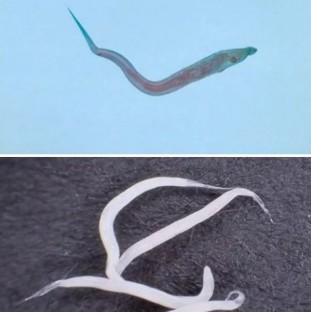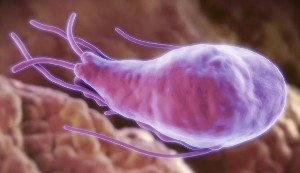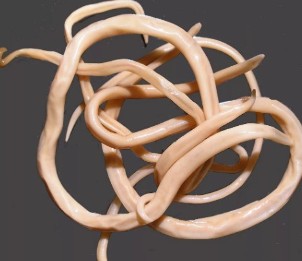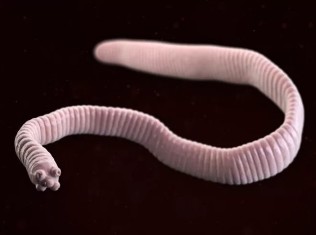The types of malarial parasites in the human body is uniquely complex. In his number, along with a bunch of tissues, in cell culture, and protozoa to also include viruses, bacteria, and fungi, they are parasites through the human body, while the medical tradition of the viruses and bacteria are not considered to be pests.

In humans, different types of parasites that are found not only in the intestine, as is commonly believed, but in many other organs: blood, tissues, muscles, joints, the brain (brain and spine), and even in his eyes.
Particularly vulnerable to these internal organs such as the gastrointestinal tract, liver, lungs, and heart.
The stay of the parasites in the human body, far from being innocuous. Of its harmful effects, it is, above all else, is that they absorb a large part from the maintenance of useful substances, without which the full functionality of the body is impossible.
The imbalance was further aggravated by the intoxication of the organism of a person on account of the toxins that are allocated to the pests, which can lead to the development of a number of diseases and even malignancies. Many times, these diseases are caused by parasites, make chronic.
The danger lies in the fact that it is a disease that the parasite causes the symptoms characteristic of other, quite often, intestinal infections, therefore, it is of great importance, it is important to make a differential diagnosis to identify the type of parasite and the production of the proper repair to be used.
Types of parasites of man, and, in general, can be divided into two main groups:
- ectoparasite, a parasite on the body surface and feeding on the blood of people, bed bugs, fleas, lice, mites); they serve for the control of vector-borne pathogens infection, such as encephalitis, typhoid fever, anthrax, and Dr;
- endoparasite parasitic on the internal organs and lead to serious illnesses, and to him belong the most simple (Giardia, amoeba, trichomonas, Toxoplasma) and helminths – parasitic worms (worms that).
Classification of the parasites

Let's see in more detail the most common types of endoparasites person. Look a lot of them, you can only see them under a microscope, but some, especially in the number of worms, are impressive for their size. Let's start with the simplest:
- Giardia, along with dysbiosis are a cause of hipovitaminose, anemia, and toxicity in the body.
- Toxoplasma surprise, the brain, the eyes, the heart muscle, the central nervous system, but they do represent a special risk to pregnant women because of the risk of fetal death, or heavy loss.
- Amoebae are capable of causing amoebic dysentery, amoebic encephalitis and other serious diseases.
- Trichomonas are a source of infectious diseases of the urinary system.
The parasites, the most common
The most common endoparasite concern, certainly, helminths (worms), which, according to several sources, contaminated by more than 80% of the world's population.
A large number of these parasites, it is divided into the main types:
- hookworm – worm parasites (roundworm, pinworms Trichinella the genus meloidogyne, and Dr);
- cestodes – flatworms-ribbon (lantecy, pork and beef tapeworm, Echinococcus, and Dr);
- trematodes – worms-flukes (liver, blood cells, lungs, as well as in the worms, the microbes in the gut).
Sometimes, you may find that the more general the classification, according to which all types of parasites, and that the people are divided as follows:
- intestinal diseases, to infest in the intestine;
- the tissue is located in other organs and tissues.
However, the majority of the worms at different stages of the cycle of life goes on, and the tissue, and the gut during the development with their symptoms.
Let's look at a brief overview of the most common types of helminths.
Roundworms (ancilostomídeos)
- Of the roundworm – the most common of the roundworms in length from 20 to 40 cm), parasitic in the small intestine, but it is the pre-migrates in the human body, and capturing the circulatory and the respiratory system. Along with the bowel of parasites, it may experience in the liver and the gall bladder, the heart and the lungs. A frequent symptom of the million with ascaris – an unusual or allergic reaction.
- Pinworms – small worms, up to about 1 cm, which affects the intestines and can cause enterobiasis disorder of the work of the digestive system, exhaustion, sleep disorders, and Dr. the Feature of the presence of the vermin – itch in the region of the anus, where they lay their eggs in it.
- Trichinella – the worms are "microscopic" (it is only a few millimeters), leading to a high disease – trichinosis, which can, if not treated, lead to death. For the adults, the kinds that dwell in the body of the people in that muscle (breathing, facial, and Dr), thus causing muscle aches, fever, swelling, skin rash, itching allergic.
- Trichuris – small worms, the length of up to 4.5 cm long, with the anterior part of the body

The larvae, which cause trichocephalosis, diarrhea, acute abdominal pain, and other symptoms of approaching appendicitis. Due to the toxicity of the body develops anemia.
The tape-worms (cestodes)
- In a large, cosmopolitan, and the length of the body, which can be as high as 10 m, which leads to the development of the difillobotrioz such as nausea, weakness, vomiting, unstable chair, asthenia, and anemia.
- The pork tapeworm has a length of from 3 to 8 m, which infects mainly in the small intestine, and immediately calls for the two-disease: taeniasis with the dyspeptic, asthenic-neurotic and abdominal pain syndromes, and cysticercosis, with intoxication, intestinal upset, allergic reactions, and respiratory conditions. Depending on the location of the tsistitserki are affected, the muscles, the brain, the heart, the eye, and the Dr.
- The high-cosmopolitan, the length of which can reach up to 18 m, which is called the beef tapeworm, infection, and is considered to be one of the most dangerous types of intestinal worms. If you don't make dehelmintization, they are able to live in a human body before they are 18 to 20 years old. It is located around the gut, leads to a strong poisoning of your life, as well as diarrhoea, nausea, vomiting, abdominal pain, anemia, allergic reactions, and problems with the nervous system.
- A dwarf tapeworm and the length is from 1.5-5 cm, the gimenolepidoz with the dyspeptic, armbar, and asthenic-neurotic syndrome, who have, above all, the digestive tract and the nervous system of the body, as well as in the liver.
- Echinococcus is considered to be the finest tape for the end-to-end – its length is only 2.5 to 8, rarely 9-mm, however, the infection is that they have terrible consequences in the form of lesions on the liver and the lung, where they form cysts, and tumors, which is caused by the dysfunction of these organs.

Worms-flukes (trematodes)
- The liver fluke or the liver fluke a manner similar to a leaf length of about 30 to 50 mm, and a width of 8-13 mm, and has a " sucker." It disrupts the shell of the liver and is blocking the bile ducts, is able to overlap fully the exit the bile. It can lead to cirrhosis, jaundice and cancer of the liver.
- Cat - (a) a fluke, or a cat flounder, smooth, end-to-end length of 4-13 mm in diameter. Location of the duct from the gall-bladder, liver, and pancreas. Called opisthorchiasis, with the development of gastritis, ulcers, pancreatitis, cholecystitis, to the cancer of the liver, which can be life-threatening.
- The lung fluke has the egg-shaped form, with red-brown body with a small peak to the length of 7.5 to 12 mm, and a width of 4 to 8 mm in diameter. It affects the lungs by causing inflammation, exudative pleural effusion, focal fibrosis, and lung cancer. Upon entering the brain it can cause encephalitis, and meningoencephalitis.
- Schistosoma (blood flukes) – dioecious worms to a size of 1-2 cm, it is the eggs that cause an increase in the liver, spleen, and lymph nodes, and the formation of polyps in the bowel, diarrhea, granulomatous inflammation, leading to cancer of the bladder.
The sources of infection

Helminthiasis can cause many health problems, shortening the life of 15-25 years of age. Many of the parasites that are extremely difficult to detect. They can be just about anywhere - in the blood, intestines, lungs, heart, and brain. The symptoms of a worm invasion may be confused with viral infections, RESPIRATORY conditions, GASTROINTESTINAL disease, and others. The fundamental error in all such cases, the on - time delivery! If you have concerns about the presence of pests, then you need to consult with an expert. If you even talk about the drugs and the self-healing, something that the most common helminths (Ascaris, flukes, tapeworms) that is appropriate antiparasitic compound.
Helminthiasis, other bowel diseases, so it is more likely that the "deadly hands dirty", which results in the entry of eggs and larvae of worms in the human body:
- when you don't wash their hands after using the bathroom and before you eat.
- don't wash the vegetables, fruits, and vegetables, which are consumed in raw form;
- do not expose the meat to the fish, a sufficient heat treatment;
- when the consumption of the wrong fish, salt, and fat;
- leave the preparations of the food available for the flies and cockroaches;
- use the stool as fertilizer in the garden, the more proud of the way areas.
- the friar is not intended for this body of water.
- the contact with the street animals.

However, you and your pet can also be infected by a worm, after all, many of the animals that serve as intermediate hosts for the worms, and the primary host is the human.
The methods used in the fight
- From a very young age and taught their children the habit of washing their hands. They will need to do it more often, as they are constantly Potter in the sand, on the ground, pools of water, where the conditions are favorable for the eggs and larvae of parasites and to be in contact with the family and the vendors of the animals.
- When you see any detainee who is not to be excluded in the helminthiasis, therefore, it is recommended to do the corresponding analysis of the parasites in order to determine the specific type of helminth ova (as opposed to the majority of them are prescription drugs.
- If the parasites are found in one member of a family of drugs helmintíasea need to take all of them.
- Folk medicine known a lot of ways on how to get rid of the worms, and they will give you a nice effect.
- So don't leave it out in the open and cooked, bread, baked goods, and PR. for fruit flies or cockroaches carry their eggs in not-for – left-them-on products.
- Carefully observe the way that the temperature in the process of cooking meat and fish, and often found the eggs of helminths, as well PRto overeat/PRto agrivate zone.
- Washed thoroughly under running tap water vegetables, fruits, and herbs, which are consumed in the raw form.
- Regularly, the grace, the cure of worms in your pets.
- To abandon the use of faeces as a fertilizer in your garden, the more proud of it.
- When you are traveling to exotic countries is extremely cautious about the local cuisine, especially those that are offered on the street, there is no guarantee that you will not put on something less exotic worms.






































